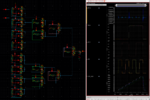OG_
Newbie level 6
I'm designing an Analog MUX in IC in cadence virtuoso that will be addressed using a 4 bit decoder (so a 16:1 analog MUX). My first idea was to use a transmission gate (nmos + pmos with inverter). However, my adviser thought this was overkill and that just an nmos would work. Here is some info:
First question: I am simulating the difference between the transmission gate and the nmos, but I'm wondering if there is a general concern/guiding principal concerning analog MUXs and transmission gates vs just an nmos. I know usually transmission gates are used to prevent Vt drops, but since my signal will be DC value -0.7 - 1 V would just the nmos work or are there other benefits to using the transmission gate?
Second question. Additionally, the first analog MUX I designed I used a design that had 4 stages (one for each bit) and looked like so:

However, my adviser said to combine them into one stage and then using it with just 16 nmos gates in a row like so (with proper digital controls accordingly):

This looks wrong to me, but maybe that's because I am just out of IC class and in class we never would design something like that, but my simulations are okay so far.
Second question: What are some possible flaws to a design like this? So far, my simulations have been okay, but I have not simulated it a lot yet. Would the output capacitance be large? Like I said, there is a constant current source on the output of the MUX that is pulling a constant 100 micro amps.
- I am using a bipolar power supply (+/- 2.5V) and my signal going into the analog MUX will have DC values around -0.7V to -1V.
- I am very concerned with noise, delay, and gain.
- My signal will be 1 Hz - 5 KHz, so not super high frequency, and on the order of 100's of microvolts to several mV.
- I have a source follower before the MUX with the current source of the source follower after the MUX which is an ideal current source probably around 100 micro amps.
First question: I am simulating the difference between the transmission gate and the nmos, but I'm wondering if there is a general concern/guiding principal concerning analog MUXs and transmission gates vs just an nmos. I know usually transmission gates are used to prevent Vt drops, but since my signal will be DC value -0.7 - 1 V would just the nmos work or are there other benefits to using the transmission gate?
Second question. Additionally, the first analog MUX I designed I used a design that had 4 stages (one for each bit) and looked like so:

However, my adviser said to combine them into one stage and then using it with just 16 nmos gates in a row like so (with proper digital controls accordingly):

This looks wrong to me, but maybe that's because I am just out of IC class and in class we never would design something like that, but my simulations are okay so far.
Second question: What are some possible flaws to a design like this? So far, my simulations have been okay, but I have not simulated it a lot yet. Would the output capacitance be large? Like I said, there is a constant current source on the output of the MUX that is pulling a constant 100 micro amps.